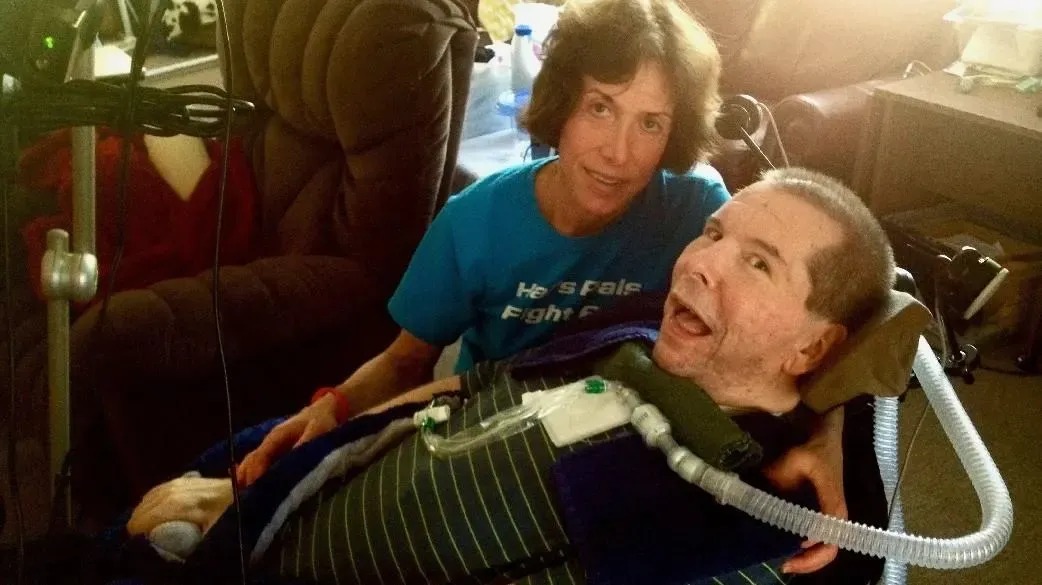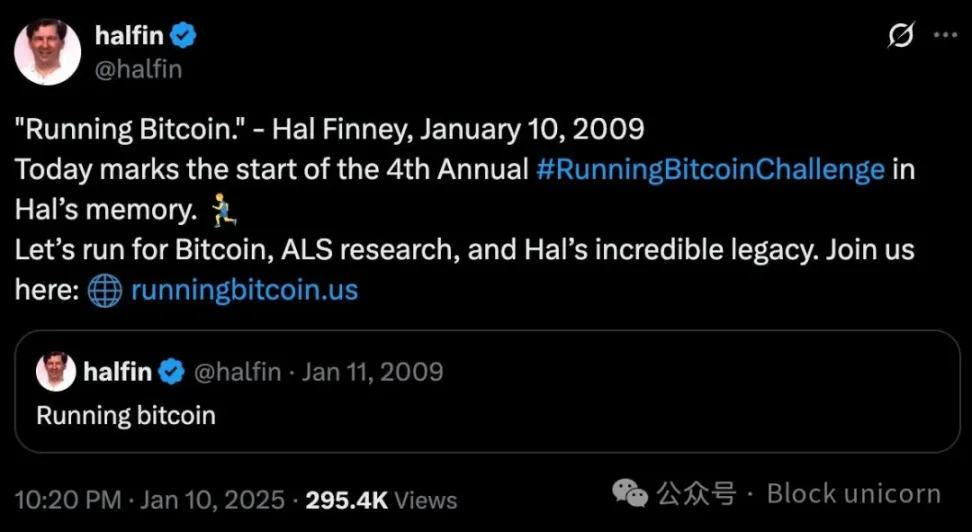Behind the code and cryptography, cryptocurrency is ultimately about people and their desire for a better world.
Written by: Token Dispatch and Thejaswini M A
Compiled by: Block unicorn
Preface
"Running Bitcoin," read a tweet. Simple and unadorned, just a few words, posted on January 11, 2009. Behind this brief message was Hal Finney, who became the recipient of the first Bitcoin transaction in history: just a day later, Satoshi Nakamoto sent him 10 BTC directly.
While the debate over Satoshi's identity is fierce, one fact is indisputable: without Hal Finney, Bitcoin might have remained an obscure white paper rather than the financial revolution we know today.
Although he passed away in 2014 due to amyotrophic lateral sclerosis (ALS), his legacy continues to shape the evolution of cryptocurrency.
From his early work on privacy software to his final contributions made through eye-tracking technology after becoming physically paralyzed, Finney's life seems to be a blueprint of the cyberpunk values embedded in Bitcoin's DNA.
From Coalinga to Cypherpunk
Born on May 4, 1956, in Coalinga, California, Harold Thomas Finney II exhibited an early talent for mathematics and computing. After earning an engineering degree from Caltech in 1979, he began his career in the video game industry.
At Mattel Electronics, Finney developed several well-known console games, including "Adventure," "Armored Encounter," and "Space Attack."
Finney's career trajectory and the development of digital currency itself cannot be separated from the backdrop of the cypherpunk movement that emerged in the late 1980s and early 1990s.

Cypherpunks are a loose collective of privacy advocates, cryptographers, and libertarian technologists who believe that strong cryptography can protect civil liberties from government intrusion and reshape society. The foundational text of the movement, Timothy May's "Crypto Anarchist Manifesto," proclaimed that cryptographic technology would fundamentally change the nature of government regulation and taxation.
Finney found his intellectual home among these digital revolutionaries. The cypherpunk mailing list, established in 1992, became an important platform for discussing revolutionary ideas about privacy, anonymity, and freedom in the digital age.
By the early 1990s, Finney joined PGP Corporation, collaborating with cryptographic pioneer Phil Zimmermann to develop "Pretty Good Privacy" (PGP), an encryption software designed to protect email communications from surveillance. This was not just technical work but also political activism, as the U.S. government at the time classified strong encryption technology as munitions, restricting its export and subjecting it to the same regulations as weapons.
Finney operated two of the earliest cryptographically-based anonymous remailer systems, allowing people to send emails without revealing their identities. This was radical technology in the early 1990s, embodying the cypherpunk motto: "Cypherpunks write code."
Digital Cash Experiments
Finney's concern for privacy naturally led him to an interest in digital currency.
For cypherpunks, this connection was obvious: in an increasingly monitored world, financial privacy represents one of the last frontiers of personal freedom.
This interest was not unique. Other cypherpunks like David Chaum, Adam Back, Wei Dai, and Nick Szabo proposed various digital cash systems in the 1990s. Finney studied their work closely and communicated extensively with Wei Dai and Szabo.
In 2004, Finney created his own digital currency system called Reusable Proof of Work (RPOW).
Based on Adam Back's Hashcash concept, RPOW aimed to solve the "double-spending problem" through a unique method: tokens that could only be used once, preventing the same digital currency from being used multiple times.
The system created RPOW tokens by allowing clients to provide a proof-of-work string of a given difficulty (signed by their private key).
The tokens would then be registered on the server to that signing key. Users could transfer tokens by signing a transfer order to another public key, and the server would update the registration accordingly.
To address security concerns, RPOW utilized the IBM 4758 secure cryptographic coprocessor, making the server more trustworthy than traditional systems. Although RPOW never gained widespread adoption, it represented a crucial step toward Bitcoin, showcasing Finney's profound understanding of how to create digital scarcity.
When a mysterious figure named Satoshi Nakamoto published a white paper titled "Bitcoin: A Peer-to-Peer Electronic Cash System" to a cryptography mailing list in October 2008, most readers dismissed it. Cryptographers had seen too many grand plans from "clueless newcomers" before.
But Hal Finney saw something different.
The First User of Bitcoin
"I think I was the first person to run Bitcoin, aside from Satoshi," Finney later recalled. "I mined the 70th block, and I was the recipient of the first Bitcoin transaction when Satoshi sent me ten bitcoins as a test."
This transaction in January 2009—Satoshi sending Finney 10 BTC—has become legendary in cryptocurrency lore, marking the transition of Bitcoin from theory to a functioning system.

In response to the Bitcoin white paper, Finney wrote:
"Bitcoin seems like a very promising idea. I also think that a form of token that cannot be counterfeited, if its production rate is predictable and not subject to corrupting influences, could have potential value."
In the following days, Finney communicated with Satoshi via email, reporting bugs and suggesting fixes. Unlike many cryptographers, he recognized Bitcoin's potential early on.
His enthusiasm was not blind optimism. In a now-famous post from 2009, he wrote:
"Think about how to reduce the carbon emissions associated with the widespread implementation of Bitcoin."
This indicated that he had begun to consider the environmental impact of cryptocurrency mining.
Based on his rough calculations, each Bitcoin could be worth $10 million. At the time, Bitcoin was worth just a few cents, making this prediction seem absurd. Today, with Bitcoin hovering around $100,000, this prediction appears increasingly prescient.
The Tragic Diagnosis and Lasting Legacy
2009 was both a victory and a tragedy for Finney. While exploring Bitcoin's potential, he received devastating news: he had been diagnosed with amyotrophic lateral sclerosis (ALS), the same disease that afflicted Stephen Hawking.
ALS leads to the degeneration of motor neurons, ultimately causing patients to lose the ability to walk, speak, or breathe independently. Typically, the time from diagnosis to death is two to five years.

However, even as his body gradually deteriorated in the last years of his life, Finney's mind remained sharp, and his spirit indomitable.
He continued to contribute to the development of Bitcoin and learned to program using eye-tracking software during his paralysis. He estimated that his programming speed was about 50 times slower than before he fell ill.
Finney even developed software that allowed him to control a mechanical wheelchair through eye movements—demonstrating his innovative problem-solving ability even under severe physical limitations.
On August 28, 2014, 58-year-old Hal Finney passed away from complications of ALS. In accordance with his wishes, his body was cryogenically preserved at the Alcor Life Extension Foundation in Arizona, marking his final optimistic expression of technology's potential to overcome human limitations.
Connection to Satoshi
When discussing Hal Finney, speculation about whether he could be Satoshi Nakamoto is inevitable.
Finney lived in Temple City, California, next door to a Japanese-American named Dorian Nakamoto.
Some have speculated that Finney might have borrowed his neighbor's name as a pseudonym.
He possessed the technical skills, philosophical stance, and writing style consistent with Satoshi's communications.
Satoshi disappeared from public view in April 2011, roughly coinciding with the deterioration of Finney's health.
Finney consistently denied being Satoshi, and evidence suggests they were different people.
Moreover, the Bitcoin private keys controlled by Satoshi have remained unused since his disappearance, making it unlikely that Finney could have accessed them.
Finney's wife, Fran, provided a compelling rebuttal, consistently asserting that her husband was not Satoshi. Given Finney's candor about his involvement in Bitcoin activities and his deteriorating health, he seemed to have no reason to maintain such a deception.
Regardless of whether he was Satoshi, Finney's contributions to Bitcoin and cryptocurrency are immense.
Since Finney's passing, his legacy has continued in various forms of tribute within the cryptocurrency space.
His wife, Fran Finney, established an annual "Bitcoin Run Challenge" to raise funds for ALS research, inspired by Finney's iconic tweet from 2009.
The event invites participants to run, walk, or roll any distance while raising funds for the ALS Association.
The "Running Bitcoin Challenge" has become a significant event on the crypto community calendar. In 2023, the challenge raised over $50,000 for ALS research, and the 2024 event surpassed that figure, highlighting the respect Finney continues to receive.
Fran has also taken over Hal's Twitter account, sharing stories and responding to the crypto community's ongoing gratitude, keeping his memory alive.

The timing of the U.S. Securities and Exchange Commission's approval of the first Bitcoin spot exchange-traded fund (ETF) coincides with the date of Finney's historic tweet 15 years later, on January 11, 2024.
Our Perspective
For many in the cryptocurrency space, Finney represents an ideal: a talented technologist who combined technical expertise with ethical principles, remaining optimistic even in the face of personal tragedy, and viewing technology as a tool for achieving human freedom.
While Satoshi remains shrouded in mystery, Finney serves as the human face of Bitcoin, reminding us that behind the code and cryptography, cryptocurrency is ultimately about people and their desire for a better world.
Hal Finney's story forces us to confront some uncomfortable questions: what do we truly value in the cryptocurrency space?
While the cryptocurrency industry celebrates wealth creation and technological disruption, Finney's legacy challenges us to think about a more fundamental question: what are all these innovations really for?
What began as a movement to protect personal freedom through mathematics has sometimes evolved into forms similar to the financial systems it sought to replace—centralized, extractive, and often opaque.
Finney's approach to technology seems straightforward: build tools that expand human freedom. Not freedom as an abstract political concept, but actual, everyday freedom—communicating without surveillance, transacting without permission, and retaining ownership of one's digital identity.
His life showcased the power of personal integrity in technological development. Unlike many who compromise their principles for market demands, Finney maintained remarkable consistency between his values and his work. From PGP to RPOW to Bitcoin, each project represented another step toward the same goal: enhancing individual autonomy through cryptography.
The industry should ask itself: do the systems we build align with Hal Finney's vision and help advance the cypherpunk dream? Or have we lost sight of the original revolutionary direction in our pursuit of the next price surge?
免责声明:本文章仅代表作者个人观点,不代表本平台的立场和观点。本文章仅供信息分享,不构成对任何人的任何投资建议。用户与作者之间的任何争议,与本平台无关。如网页中刊载的文章或图片涉及侵权,请提供相关的权利证明和身份证明发送邮件到support@aicoin.com,本平台相关工作人员将会进行核查。




